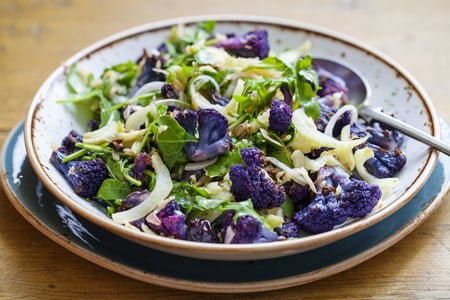Purple cauliflower. Congee. Skhug sauce. Cajeta. Chermoula. 
Are you scratching your head? Don’t worry: Restaurateurs across the country are doing the same. These five foods are among dozens, if not hundreds, predicted to be the flavor trends of 2017. (And in case you, like us, need a cheat sheet: congee = rice porridge, skhug = Yemeni/Israeli hot sauce, cajeta = a sweet, caramelized goat’s milk sauce and chermoula = a green Moroccan marinade made with lemon and herbs).
But how popular will these, or any other, fashionable flavors really be with your diners? Here are a few tips for identifying food trends worth following.
Menu trends: Prediction, fad or new norm?
A food fad is something that’s novel and intensely popular for a very short period of time. These days, food fads must also be visually appealing to achieve social-media stardom. Recent examples include over-the-top milkshakes with elaborate toppings, like an entire slice of birthday cake; Bulletproof coffee, a blend of coffee and butter; and cups of rich bone broth. Food fads are usually the creation of one chef or restaurant owner, then imitated and improved upon by others.
Food trends, unlike fads, may influence menus for years. Think kale and bacon, or food trucks and pop-ups. “True food trends move at kind of a glacial pace,” Annika Stensson, director of research communications for the National Restaurant Association, tells The New York Times. “It can take a decade or more to reach the mainstream.”
Some food trends have so much staying power that they never go away. It’s hard to imagine diners demanding more artificial ingredients in their food, for instance, or increasing sugary soda intake to the 53 gallons per person Americans were drinking in 1998. Current trends like clean food, local sourcing and vegan meals are probably here to stay.
Food trend predictions are something else entirely. Every year, experts offer their best guesses about the new flavors, cooking methods and ethnic cuisines that will catch on. Sometimes these predictions are based on meticulous research. And sometimes they’re driven by marketers who only want to sell more piri-piri pepper sauce.
Identifying food trends that resonate with diners
As food trend predictions roll in, chefs and restaurateurs have to sift through the lists and decide which, if any, have a place on their menus. Here’s one helpful rule: Most food trends worth paying attention to are those that build on other past, successful trends. If your diners have been enthusiastic about alternative grains like quinoa and chia, it’s a good bet they’ll be interested in teff. Given widespread interest in “good” fats and nut butters, as well as the recent growth of avocados on menus, it makes sense that people would become fans of avocado oil, Datassential reasons. And fermentation, a popular 2016 food trend that’s still kicking, arose from many sources, Stensson says: the farm-to-table movement, increased interest in Nordic and Korean cuisine, and growing awareness of probiotics.
So which 2017 food trends may actually take off? We’re seeing several that are echoed across many different lists, notably:
- African cuisine
- Filipino flavors
- Mediterranean/Middle Eastern breakfasts
- Low-alcohol cocktails/aperitifs
- Charred and smoked foods
- Delivery-only restaurants
- Sous-vide cooking
Not all of these fit with every restaurant concept, of course, but some may be worth exploring. Then, too, there’s the cost-benefit calculation of trying a trendy food. If you have an empty slushie machine or an underused bar blender, why not add frosé to the menu this summer?
Just remember that while fun fads may lure in patrons, the strength of the core menu is what really matters. Just ask the king of the crazy-milkshake trend, Black Tap Craft Burgers and Beer owner Joe Isidori. A year after the trend began, he has three locations in New York City and the lines are still two hours long. Isidori’s secret: His burgers are genuinely good. People come for the shakes, but they come back for the beef. “Trends come and go, but the burger is forever,” he likes to say.
How has your company adopted — or adapted — new food trends? Tell us about it here! We may feature your business on our blog, which reaches an international community of foodservice professionals.


